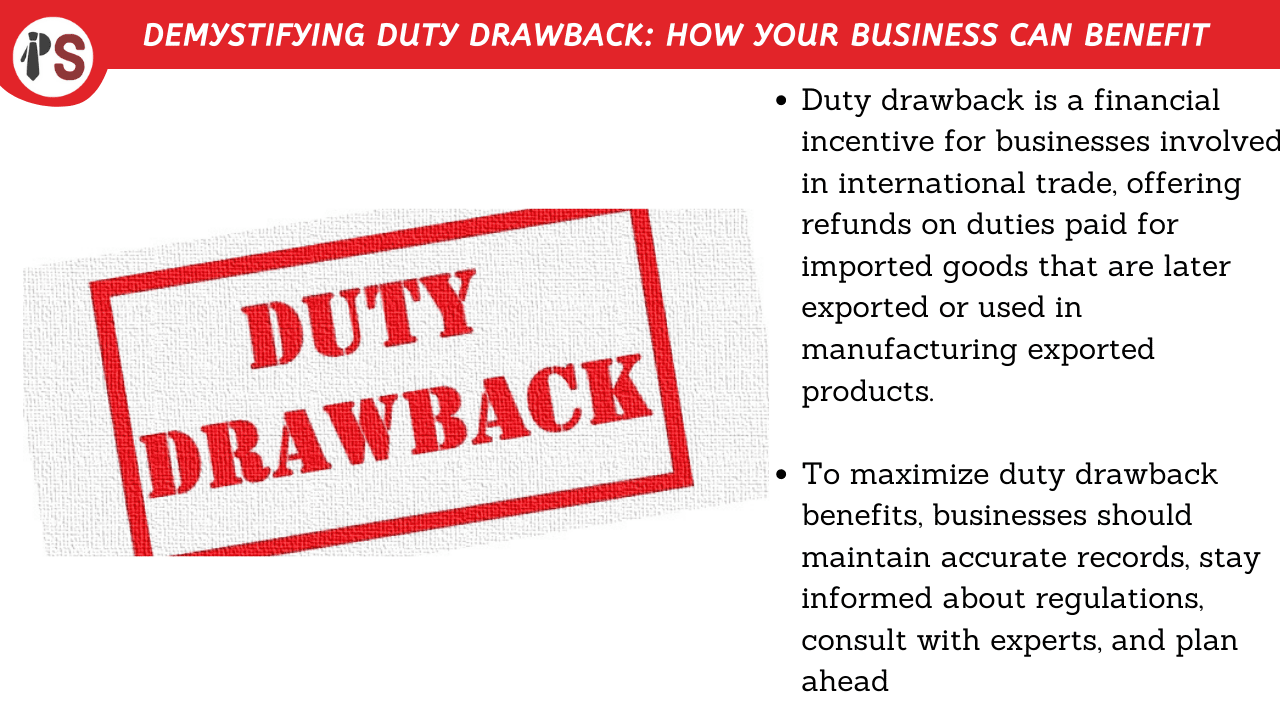
Duty drawback is a financial incentive offered by governments to exporters, allowing them to recover a portion of the duties, taxes, or fees paid on imported goods that are subsequently exported or used in the production of exported goods. This article provides an in-depth look at duty drawback, its benefits, and the process involved in claiming it.
What is Duty Drawback?
Types of Duty Drawback
Benefits of Duty Drawback
Eligibility Criteria
The Duty Drawback Claim Process
Documentation Requirements
Tips for Maximizing Duty Drawback
Conclusion
Duty drawback is a refund mechanism that enables businesses to recover a portion of the customs duties, taxes, and fees paid on imported goods that are later exported or used in the production of exported goods. This incentive encourages businesses to export products and helps them remain competitive in the global market.
Governments around the world, including the United States and India, offer duty drawback programs to support their domestic industries and boost exports.
There are typically two types of duty drawback:
Manufacturing Duty Drawback: This applies to goods that are imported, used in the production of export goods, and then exported. Businesses can claim a refund on the duties paid on the imported inputs used in manufacturing the exported products.
Unused Merchandise Duty Drawback: This applies to goods that are imported and then re-exported without being used or altered in any way. Businesses can claim a refund on the duties paid on the imported goods that are subsequently exported in the same condition.
Duty drawback offers several benefits to businesses, including:
Cost Savings: By recovering a portion of the duties and taxes paid on imported goods, businesses can reduce their overall costs and improve their profitability.
Enhanced Competitiveness: Duty drawback helps businesses remain competitive in the global market by offsetting the cost disadvantages associated with importing goods and materials.
Cash Flow Improvement: Duty drawback refunds can improve a company's cash flow, providing additional working capital for business operations and growth.
To be eligible for duty drawback, businesses must meet the following criteria:
The imported goods must be subject to customs duties, taxes, or fees.
The imported goods must be used in the production of exported goods or exported in the same condition without being used or altered.
The exported goods must be shipped within a specified time frame (usually within one to three years) from the date of importation.
The claimant must be able to provide documentation supporting the claim, including proof of import, duty payment, and export.
The duty drawback claim process typically involves the following steps:
Determine eligibility: Businesses must first determine if their imported goods and subsequent exports qualify for duty drawback.
Maintain records: Businesses should maintain accurate records of imported goods, duty payments, and exports to support their duty drawback claims.
Submit a claim : The claimant must file a duty drawback claim with the appropriate customs authority within the specified time frame. The claim should include all required documentation and information.
Customs review: The customs authority will review the claim and may request additional information or documentation. They may also conduct audits or inspections to verify the claim.
Refund processing: If the claim is approved, the customs authority will issue a refund for the eligible portion of the duties, taxes, or fees paid on the imported goods.
To support a duty drawback claim, businesses must provide the following documentation:
Proof of importation, such as a customs entry document or import invoice.
Evidence of duty payment, such as a customs duty receipt or statement of account.
Proof of export, such as shipping documents, export invoices, or airway bills.
Records demonstrating the use of imported goods in the production of exported goods (for manufacturing duty drawback claims).
Any additional documents or information required by the customs authority.
To maximize the benefits of duty drawback, businesses should consider the following tips:
Maintain accurate records: Proper record-keeping is essential for supporting duty drawback claims. Keep track of imported goods, duty payments, and exports to ensure you have the necessary documentation when filing a claim.
Stay informed about duty drawback regulations: Duty drawback regulations may vary by country and can change over time. Stay informed about the rules and requirements in your jurisdiction to ensure you are taking full advantage of available duty drawback benefits.
Consult with experts: Work with customs brokers, consultants, or legal advisors experienced in duty drawback to help you navigate the process and ensure you are maximizing your duty drawback benefits.
Plan ahead: Consider duty drawback when making decisions about sourcing, production, and exporting. Incorporate duty drawback planning into your overall business strategy to maximize cost savings and competitiveness.
Duty drawback is a valuable financial incentive for businesses involved in international trade. By understanding the eligibility requirements, maintaining accurate records, and staying informed about duty drawback regulations, businesses can maximize their duty drawback benefits and improve their overall competitiveness in the global market.
At Professional Saathi, we offer a range of business consultancy services that help businesses improve their performance, achieve growth, and overcome challenges.
Copyright 2025 © Created By KTPG PROFESSIONAL SAATHI CORPORATE CONSULTANT PRIVATE LIMITED, All Rights Reserved.
Leave Your Comment